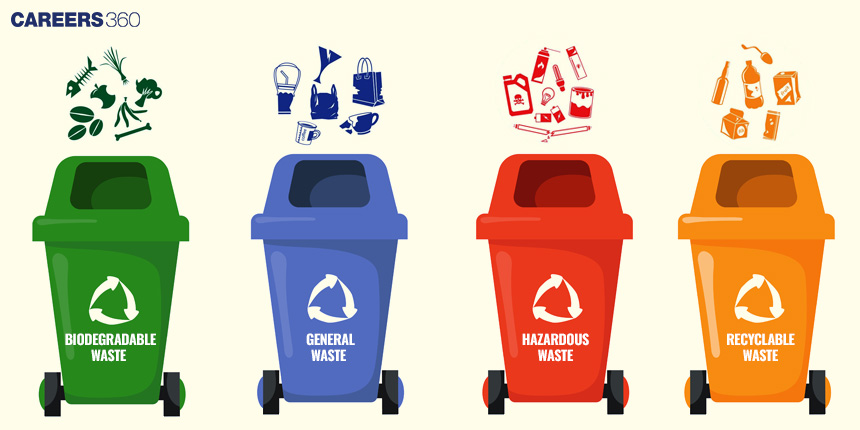Solid Waste Management: Definition, Methods, Importance, Types, Sources
Solid waste management definition: Solid waste management is the process of collecting, treating, and disposing of waste materials produced by human activity. It aims to reduce the negative impact of waste on the environment and human health by managing various types of waste, including household, industrial, and hazardous materials. In this article, solid waste management, classification of solid waste, sources of solid wastes, methods of solid waste management, waste treatment and disposal, and environmental and health impacts of improper waste management are discussed. Solid Waste Management is a topic of Environmental Issues in Biology.
Don't Miss: Most scoring concepts for NEET | NEET papers with solutions
NEET 2025: Syllabus | PYQs | Crack NEET in 2 months - Study Plan
NEET Important PYQ & Solutions: Physics | Chemistry | Biology | NEET PYQ's (2015-24)
- What is Solid Waste Management?
- Classification of Solid Waste
- Sources of Solid Wastes
- Methods of Solid Waste Management
- Waste Treatment and Disposal
- Environmental and Health Impacts of Improper Waste Management
- Recommended Video for Solid Waste Management

What is Solid Waste Management?
Solid waste is generally referred to as a wide catch-all category for a large portion of the trash materials that become by-products of human and animal activities and thus are discarded as unwanted and useless. This term includes varied types of waste emanating from households, industries, healthcare institutions, and agricultural sectors. It is the comprehensive procedure for the collection, treatment, and disposal of solid wastes in such a way as to ensure that public health and the environment are protected. It involves control of waste generation, storage, collection, transport, processing, and disposal of waste elements.
It is hard to overstate the importance of solid waste management. Solid waste management includes a reduction in environmental pollution and conserving resources by recycling and reusing materials. Managing waste also reduces the health hazards from waste. The different varieties of solid wastes—municipal solid wastes, industrial wastes, biomedical wastes, hazardous wastes, and agricultural wastes—all require different management strategies for their processing and handling in a sustainable way.
Classification of Solid Waste
Solid waste is classified as follows:
Municipal Solid Waste
Municipal solid waste includes household and commercial waste. Household wastes are everyday things that are commonly discarded by households like food scraps, papers, plastics, glass, and metals. Commercial wastes emanate from businesses and commercial establishments and comprise packaging materials, wastes from offices, and food waste.
Industrial Solid Waste
Industrial solid waste emanates from industries involved in manufacturing, mining, and construction processes. Most of the wastes produced in these industries often have chemicals, heavy metals, and other dangerous elements that call for careful handling and disposal.
Biomedical Waste
Biomedical wastes are produced in health care centres like hospitals and clinics. It comprises syringes, bandages, or any other materials that are soaked in blood or other body fluids, hence highly infectious, and in most cases, require special treatment and ways of disposal.
Hazardous Waste
Hazardous wastes are wastes that pose a threat to human health and the environment by being toxic, corrosive, highly flammable, or reactive. Examples include chemicals, batteries, and electronic waste.
Agricultural Waste
Agricultural wastes are wastes originating from agricultural-related activities and include crop residues, animal manure, and pesticides. It is always essential that agricultural waste be handled and treated with proper management for environmental safety and a green future of sustainable agriculture.
Diagram of Solid Waste Management
The diagram below shows that different types of solid waste are treated separately

Also Read-
Sources of Solid Wastes
The various sources of solid waste are:
Residential Sources
Residential sources of solid waste are those produced by households resulting from daily activities. They include food remains, materials used for packaging, and other everyday items.
Industrial Sources
Industrial sources of solid waste are from manufacturing and production processes. They may include scrap materials, chemicals, and unused by-products that emanate as a result of an industrial process or production.
Commercial Sources
Commercial sources of solid waste are businesses such as retail stores, offices, and restaurants. Most often present in this type of refuse are food wrappings, office supplies, and leftover foods.
Institutional Sources
Sources of institutional nature include schools, hospitals, and government buildings. This could also be from paper and office equipment to hazardous medical wastes.
Construction and Demolition Sites
Construction and demolition sites produce wastes resulting from construction, renovation, and demolition projects. This includes concrete, wood, metals, and bricks.
Methods of Solid Waste Management
The solid waste management process is described below:
Waste Collection and Transportation
Two important facets of solid waste management are effective collection and transportation. Collection systems entail the methods of collecting refuse from homes, commercial institutions, and organisations. Transportation methods denote techniques for moving wastes to treatment and disposal sites. Inadequate infrastructure, lack of funds, and logistical problems are some challenges in waste collection.
Waste Segregation
Segregation of wastes means the separating of different wastes to administrate them effectively. This process is important as it can be seen that various wastes require different methods of treatment. Sorting out includes segregative methodologies at the source, like organic, recyclable, and hazardous waste. The segregation process is on the frontline with households and institutions ensuring the waste is sorted correctly from the generation point.
Waste Treatment and Disposal
The treatment and disposal of solid wastes are undertaken in a variety of ways. Some of these are pointed out below.
Landfilling is a common method where the wastes are buried in a specially selected area. The modern design of landfills incorporates features that prevent environmental contamination. Landfilling, however, suffers from some disadvantages, mainly the use of land and the danger of pollution.
Incineration is a process of burning waste to reduce its volume and produce energy. It efficiently reduces the volume of waste but at the same time affects air quality.
Composting refers to the decomposition of organic materials into manure, which enhances fertility in soil. There are two types of composting: aerobic and anaerobic, each with its advantages.
Recycling is the process that involves the transformation of waste into reusable products. To recycle means to conserve resources and save the environment.
Anaerobic Digestion is the breaking down of organic waste in an oxygen-free environment to produce biogas. The benefit of this process is that it produces energy, but it has high development barriers.
Advanced technologies of waste management are necessary to control the complex nature and quantity of waste.
Waste-to-energy conversion treats wastes to get useful energy through various technologies.
Plasma Gasification: high temperatures to convert waste into syngas and slag.
Pyrolysis: Organic decomposition process in the absence of oxygen at high temperatures.
Bioremediation: Detoxification of hazardous waste through microorganisms.
Vermicomposting: Vermicomposting makes use of worms to decompose the organic refuse into very fine compost of high grade thus a natural and effective way of waste management.
Environmental and Health Impacts of Improper Waste Management
Improper waste management is associated with serious environmental and health effects. Notably, improper waste disposal significantly contributes to air, water, and soil pollution. Such pollution further causes several hazards to health, including respiratory problems, infections, and exposure to toxic substances. Wildlife is also affected by waste pollution since their habitats and food may be contaminated, leading to certain health complications and mortality.
Also Read-
Recommended Video for Solid Waste Management
Frequently Asked Questions (FAQs)
The broad spectrum of refuse materials resulting from human and animal activities that become discarded as unwanted and useless. It shall include household, commercial, industrial, and biomedical waste.
A good solid waste management system is highly essential for preventing environmental pollution and conservation of resources by way of recycling and re-use of scrap materials, and protection of public health from the dangers of wastes.
The methods of solid waste management are collection and transportation, segregation, treatment, and recycling. Treatment methods are by landfilling, incineration, composting, and anaerobic digestion.
Recycling helps the environment preserve natural resources, reduce the quantity of waste disposed in landfills, reduce pollution and conserve energy normally used to make new materials from raw resources.
Solid waste management is the collection, treatment, and disposal of waste materials produced by human activities. It involves methods such as recycling, composting, and proper disposal to reduce environmental impact. The aim is to manage waste efficiently to protect human health and the environment.
Also Read
25 Nov'24 10:17 AM
14 Nov'24 11:00 PM
14 Nov'24 03:31 PM
14 Nov'24 01:18 PM
14 Nov'24 11:37 AM
14 Nov'24 08:30 AM
22 Oct'24 03:31 PM
10 Oct'24 06:09 PM
